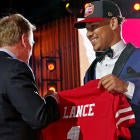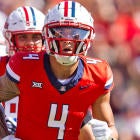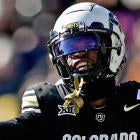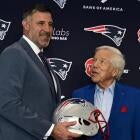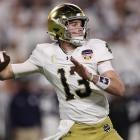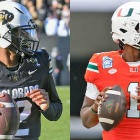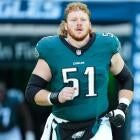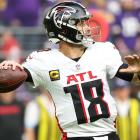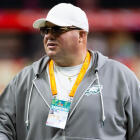
Rookies need to produce almost instantly today, or they're in danger of being dubbed as busts or players who won't ever succeed in the NFL. But not every first-year pro is created equally. Some, honestly, just need a "redshirt" season.
Below are the players picked in the first round of the 2021 NFL Draft most in need of a "redshirt" year of some sort before they should be relied upon in key roles by the team that picked them.
Disclaimer: The term "redshirt" isn't exactly meant to have the same definition as it does it college -- a player sitting out an entire season. For a few of these players that could be the case. For others, "redshirt" is simply meant to imply they should have a very limited on-field role in Year 1 as they fine-tune their skills and/or add strength in an NFL weight room.
Trey Lance, QB, 49ers
Redshirt need: Moderate
Likelihood of redshirt: Moderate
Because Lance started one year in college, and that year came as a 19-year-old at the FCS level, Lance is the most obvious redshirt candidate in the 2021 draft class. Despite the clearness of the redshirt need, I don't believe it's significant. There's a difference.
And that's mostly due to the environment Lance is in with the 49ers. Head coach Kyle Shanahan operates the most QB-friendly offense in the NFL. It can turn C.J. Beathard and Nick Mullens into competent starters for stretches and elevate Matt Ryan to MVP levels. And George Kittle is back. So is Deebo Samuel. Brandon Aiyuk returns after registering at least 75 yards in five of his final seven contests in 2020. The offensive line is relatively sturdy.
Lance seeing the field in late October/early November wouldn't be throwing the rookie into the fire too early. Would Shanahan be able to deploy his entire playbook? Probably not. And there would be ample instances in which it'd be apparent Lance isn't quite ready by conventional standards. But the way Shanahan schemes pass catchers open and the YAC uniqueness of San Francisco's skill-position group opens the door for even a clearly raw Lance to operate an efficient offense. And, if coverages are mixing too quickly and windows are closing too fast, he can lean on his legs. Shanahan will have a designed run package ready to go for his rookie whenever he starts.
After trading up for him and given Jimmy Garoppolo's seemingly tenuous grasp on the QB1 position in San Francisco, Lance will probably see the field at some point in 2021, unless the 49ers return to 2019 form with Garoppolo under center.
Gregory Rousseau, EDGE, Bills
Redshirt need: Significant
Likelihood of redshirt: Significant
Rousseau was a fourth-round prospect on my board, and the Bills picked him at No. 30 overall. Why was I so low on the Miami rusher who recorded 15.5 sacks as a redshirt freshman in 2019? Despite freaky length, I didn't see high-end pass-rushing traits -- minimal sustained speed, bad power due to height, and almost nonexistent hand work. And much of the production wasn't due to one-on-one victories.
And I'm not even faulting Rousseau for being raw. He played one college football season and was 20 years old. Nor am I faulting him for opting out. But had we seen him on the field in 2020, we potentially could've seen more advancement in his one-on-one pass-rushing toolbox.
Instead, he rode that majorly productive season to being a first-round pick. Good for him. But he has a long road ahead of him to developing what he'll need to be a consistent winner around the corner or even if/when Buffalo kicks him inside to rush against guards and centers. Because right now, Rousseau's length is his only pass-rushing asset.
Fortunately for him, due to the Bills roster makeup, it's not necessary for Rousseau to see extended action early in his NFL career. Buffalo has two established veteran outside rushers -- Jerry Hughes and Mario Addison -- drafted A.J. Epenesa in the second round in 2020, and signed Efe Obada this offseason. He finished with 29 pressures on just 281 pass-rushing snaps in 2020 on the Panthers.
Will Rousseau be a routine healthy scratch? Probably not, however, the much more pro-ready Epenesa was inactive for the season opener last year and played more than 30 defensive snaps in just two contests.
Craving even more NFL coverage focusing on previews, recaps, news and analysis? Listen below and follow the Pick Six podcast for a daily dose of everything you need to follow pro football.
Odafe Oweh, EDGE, Ravens
Redshirt need: Moderate
Likelihood of redshirt: Minimal
Oweh is another upside-based selection for a contender in the AFC. He infamously didn't record a sack in his final season at Penn State but did register 20 pressures on 163 pass-rushing snaps last season. That 12.2% pressure-creation rate is actually quite low, particularly for a first-round pick.
With Oweh, it's all about his projection and upside. Always has been. At nearly 6-5 and 257 pounds, he ran 4.37 at his pro day. Yeah, it came at a pro day, but even being close 4.37 is really moving for an edge rusher. The rest of his workout was spectacular, too. Oweh clocked under the magical 7.00-second time in the three-cone drill.
And while decently powerful with elite burst, Oweh doesn't play as bendy as the 6.90 three-cone time would typically indicate. More importantly, a classic swipe is the only effective move in his pass-rush arsenal. Frankly, Oweh doesn't try any other moves to beat blockers. That's going to be a problem in the early stages of his pro career. He'll wins some reps around the corner on burst alone. But NFL offensive tackles are a completely different animal than what Oweh faced in the Big Ten.
Given the departures of Matthew Judon and Yannick Ngakoue, Baltimore is essentially forced to playing Oweh early and often.
Micah Parsons, LB, Cowboys
Redshirt need: Minimal
Likelihood of redshirt: Minimal
I included Parsons on this list for one reason -- coverage. The Penn State linebacker was not a coverage specialist by any stretch of the imagination -- five pass breakups and no interceptions in his two years with the Nittany Lions.
In obvious passing situations, he was much more frequently aligned on the edge as a pass rusher, hanging over the A gap as a blitzer, or spying on the quarterback.
And using him in that attacking role was smart! He has legitimate capabilities to win around the corner because of his speed-to-power conversion, bend, and surprisingly developed pass-rush moves. And maybe that's how the Cowboys will deploy Parsons as a rookie.
But there will be situations in which he needs to man up with tight ends or runners out of the backfield. Even dropping into zone and making plays on the football is part of the job description for every linebacker in today's NFL. Sure, Parsons possesses the athleticism to eventually rock in coverage. But as we saw with athletic second-level defenders who went in Round 1 last year -- Kenneth Murray, Jordyn Brooks, and Patrick Queen -- it's not a cinch to hit the ground running as a coverage linebacker if that wasn't a specialty in college.
And after picking him at No. 12 overall -- even with Leighton Vander Esch and Jaylon Smith incumbent starters -- Parsons won't see limited action for too long, if at all, in his rookie season with the Cowboys.
![[object Object] Logo](https://sportshub.cbsistatic.com/i/2020/04/22/e9ceb731-8b3f-4c60-98fe-090ab66a2997/screen-shot-2020-04-22-at-11-04-56-am.png)








